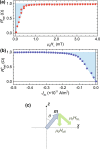Investigation of spin-orbit torque using current-induced magnetization curve
- PMID: 28400565
- PMCID: PMC5429785
- DOI: 10.1038/s41598-017-00962-7
Investigation of spin-orbit torque using current-induced magnetization curve
Abstract
Manipulation of magnetization using current-induced torque is crucial for magnetic recording devices. Recently, the spin-orbit torque (SOT) that emerges in a ferromagnetic thin film on a heavy metal is focused as a new scheme for magnetization switching in perpendicularly magnetized systems. Since the SOT provides a perpendicular effective field to the system, the formation of a magnetic multiple domain state because of Joule heating is supressed in the magnetization reversal process. This means that high reliable switching is possible using the SOT. Here, by utilizing the SOT induced domain stability, we show that an electrical current directly injected to a perpendicularly magnetized Pt/Co/Pd system can magnetize itself, that is, current-induced magnetization process from multi to single domain state. A quantitative determination of the SOT is performed using the current-induced magnetization curve. The present results are of great importance as another approach to evaluate the SOT effect, as well as a demonstration of domain state switching caused by the SOT.
Conflict of interest statement
The authors declare that they have no competing interests.
Figures





References
-
- Slonczewski JC. Current-driven excitation of magnetic multilayers. J. Magn. Magn. Mater. 1996;159:L1–L7. doi: 10.1016/0304-8853(96)00062-5. - DOI
-
- Huai Y, Albert F, Nguyen P, Pakala M, Valet T. Observation of spin-transfer switching in deep submicron-sized and low-resistance magnetic tunnel junctions. Appl. Phys. Lett. 2004;84:3118. doi: 10.1063/1.1707228. - DOI
Publication types
LinkOut - more resources
Full Text Sources
Other Literature Sources

